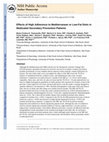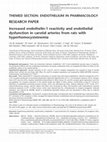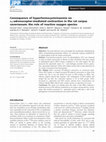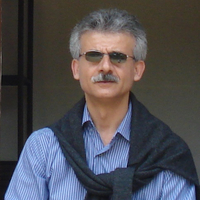Papers by Claudia de Andrade
Biology of Reproduction, 2010
Semina: Ciências Agrárias, 2014
In Vitro Cellular & Developmental Biology - Animal, 2011

The American Journal of Cardiology, 2011
Although the Mediterranean diet (MD) and the low-fat Therapeutic Lifestyle Changes Diet (TLCD) pr... more Although the Mediterranean diet (MD) and the low-fat Therapeutic Lifestyle Changes Diet (TLCD) promote equivalent increases in event-free survival in secondary coronary prevention, possible mechanisms of such complete dietary patterns in these patients, usually medicated, are unclear. The aim of this study was to investigate the effects of the MD versus the TLCD in markers of endothelial function, oxidative stress, and inflammation after acute coronary syndromes. Comparison was made between 3 months of the MD (n = 21; rich in whole grains, vegetables, fruits, nuts, and olive oil, plus red wine) and the TLCD (n = 19; plus phytosterols 2 g/ day) in a highly homogenous population of stable patients who experienced coronary events in the previous 2 years (aged 45 to 65 years, all men) allocated to each diet under a strategy designed to optimize adherence, documented as >90%. Baseline demographics, body mass index and clinical data, and use of statins and other drugs were similar between groups. The MD and TLCD promoted similar decreases in body mass index and blood pressure (p ≤0.001) and particularly in plasma asymmetric dimethylarginine levels (p = 0.02) and L-arginine/asymmetric dimethylarginine ratios (p = 0.01). The 2 diets did not further enhance flow-mediated brachial artery dilation compared to baseline (4.4 ± 4.0%). Compared to the TLCD, the MD promoted decreases in blood leukocyte count (p = 0.025) and increases in high-density lipoprotein levels (p = 0.053) and baseline brachial artery diameter. Compared to the MD, the TLCD decreased low-density lipoprotein and oxidized low-density lipoprotein plasma levels, although the ratio of oxidized to total low-density lipoprotein remained unaltered. Glucose, high-sensitivity C-reactive protein, triglycerides, myeloperoxidase, intercellular adhesion molecular, vascular cell adhesion molecule, and glutathione serum and plasma levels remained unchanged with either diet. In conclusion, medicated secondary prevention patients show evident although small responses to the MD and the TLCD, with improved markers of redox homeostasis and metabolic effects potentially related to atheroprotection.

British Journal of Pharmacology, 2009
Background and purpose: There are interactions between endothelin‐1 (ET‐1) and endothelial vascu... more Background and purpose: There are interactions between endothelin‐1 (ET‐1) and endothelial vascular injury in hyperhomocysteinemia (HHcy), but the underlying mechanisms are poorly understood. Here we evaluated the effects of HHcy on the endothelin system in rat carotid arteries.Experimental approach: Vascular reactivity to ET‐1 and ETA and ETB receptor antagonists was assessed in rings of carotid arteries from normal rats and those with HHcy. ETA and ETB receptor expression was assessed by mRNA (RT‐PCR), immunohistochemistry and binding of [125I]‐ET‐1.Key results: HHcy enhanced ET‐1‐induced contractions of carotid rings with intact endothelium. Selective antagonism of ETA or ETB receptors produced concentration‐dependent rightward displacements of ET‐1 concentration response curves. Antagonism of ETA but not of ETB receptors abolished enhancement in HHcy tissues. ETA and ETB receptor gene expressions were not up‐regulated. ETA receptor expression in the arterial media was higher ...

The Journal of pharmacy and pharmacology, Jan 4, 2016
Our main objective was to investigate the mechanisms underlying the effects of hyperhomocysteinae... more Our main objective was to investigate the mechanisms underlying the effects of hyperhomocysteinaemia (HHcy) on contractile response mediated by α1 -adrenoceptors in the rat corpus cavernosum. Concentration-response curves for phenylephrine (PE) were obtained in strips of corpus cavernosum, in absence or after incubation with tiron, tempol or polyethylene glycol (PEG)-catalase combined or not with tempol. We also measured the superoxide anion (O2 (-) ) and hydrogen peroxide (H2 O2 ) generation, superoxide dismutase (SOD) and catalase activity and α-actin expression in rat corpus cavernosum from both groups. HHcy increased PE-induced contraction in cavernosal strips. Tiron, PEG-catalase or tempol increased PE-induced contraction in strips from control rats, but it was not altered by tiron or PEG-catalase in HHcy rats, whereas tempol reduced this response. The combination of PEG-catalase and tempol did not alter the contractile response to PE in both groups. HHcy increased O2 (-) gener...











Uploads
Papers by Claudia de Andrade